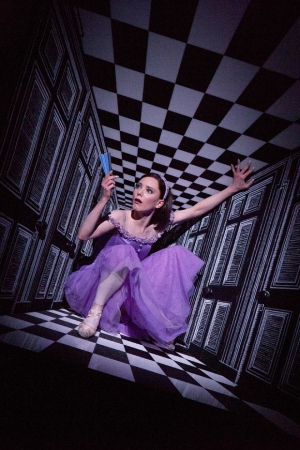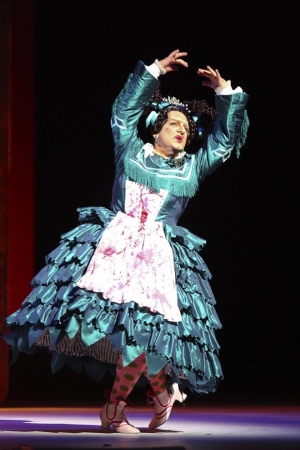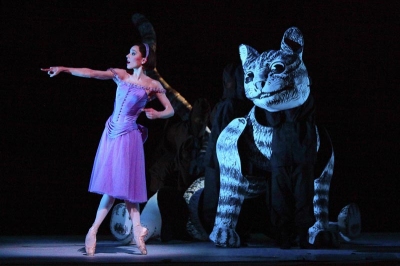

Some ballets are drugs in themselves - you’re under their sway no matter what the performance. Other ballets need drugs to help. This new Alice’s Adventures in Wonderland is definitely of the second kind, a very odd, very shallow, very bright and brilliantly bold staging, that makes no sense, that offers no depth, but which I suspect would be a blast if one were slightly stoned.
Possibly this production came into being [3] in giggly sessions between Christopher Wheeldon and his composer, designer and dramaturg, surrounded as copiously by flying cheques as Alice is surrounded by flying playing cards, but rather more brainwashed than she is by the chimera that stage design will answer all problems. (See Charlotte MacMillan's full production portfolio on theartsdesk [4].)
 It looks reassuringly expensive, as you'd expect of the first new full-length ballet at the Royal Ballet since Twyla Tharp’s Mr Worldly Wise in 1995. You never saw such a lot of props, video and scenery (Bob Crowley) - even the trees take a bow at the curtain calls. There is a mansion house and garden set, a swirling video thingumajig for the rabbit hole and a cunning shrinking room (pictured left, Sarah Lamb as Alice © Charlotte MacMillan), the Duchess’s Grand Guignol kitchen stuffed with huge pig carcasses, castles of playing cards, gardens of flowers and seas of tears, teapots and teacake pouffes. The characters are unstintingly costumed in mad hats, furry ears and whiskers (main picture), with glorious flamingo girls, hedgehog children and a Cheshire cat manipulated by puppeteers. The backcloths, lit in eyewatering primary colours, drop in and out like Christmas cards being stacked on an empty mantelpiece - an embroidered sampler house here, a cut-out garden maze there - the stage’s black wings uninvitingly cancelling out any real travel of the imagination from one place to the next.
It looks reassuringly expensive, as you'd expect of the first new full-length ballet at the Royal Ballet since Twyla Tharp’s Mr Worldly Wise in 1995. You never saw such a lot of props, video and scenery (Bob Crowley) - even the trees take a bow at the curtain calls. There is a mansion house and garden set, a swirling video thingumajig for the rabbit hole and a cunning shrinking room (pictured left, Sarah Lamb as Alice © Charlotte MacMillan), the Duchess’s Grand Guignol kitchen stuffed with huge pig carcasses, castles of playing cards, gardens of flowers and seas of tears, teapots and teacake pouffes. The characters are unstintingly costumed in mad hats, furry ears and whiskers (main picture), with glorious flamingo girls, hedgehog children and a Cheshire cat manipulated by puppeteers. The backcloths, lit in eyewatering primary colours, drop in and out like Christmas cards being stacked on an empty mantelpiece - an embroidered sampler house here, a cut-out garden maze there - the stage’s black wings uninvitingly cancelling out any real travel of the imagination from one place to the next.
Much show, but with the White Rabbit's sense of timing. The first act is a diarrhoeic 70 minutes - even MacMillan’s toughest dramas drew stumps at 45 minutes per act. This is a gigantic orchestra with weird percussion and ram's-horn trumpets emitting a positive Niagara Falls of picturesque music, two hours’ worth. Joby Talbot’s been known for the relative economy of film and TV music before, but for his industry, zeal and vigorously eclectic story-painting - with Prokofiev jokes and even Minkus jokes - he’s man of the match, though an extraction to a 45-minute concert suite wouldn't be a bad idea. The Royal Opera House orchestra under Barry Wordsworth also deserve bouquets for their infectiously bouncy delivery.
 The problem is upstairs on the stage. Christopher Wheeldon’s story approach with Alice stops dead at the challenge of making her a character, and it looks as if he abandoned the imaginative imperative to find a character for her, and moved to rely on a broad and increasingly cod form of costume comedy. At last night’s premiere, his fine choreographic voice disappeared too often in the panto capering - he makes almost nothing of the Duchess with the luxury casting of Simon Russell Beale (pictured right © Charlotte MacMillan), certainly nothing to compare with what Ashton did with Widow Simone in La fille mal gardée.
The problem is upstairs on the stage. Christopher Wheeldon’s story approach with Alice stops dead at the challenge of making her a character, and it looks as if he abandoned the imaginative imperative to find a character for her, and moved to rely on a broad and increasingly cod form of costume comedy. At last night’s premiere, his fine choreographic voice disappeared too often in the panto capering - he makes almost nothing of the Duchess with the luxury casting of Simon Russell Beale (pictured right © Charlotte MacMillan), certainly nothing to compare with what Ashton did with Widow Simone in La fille mal gardée.
This is a desperately difficult book to make into a ballet, because Alice is so resistant to the mind-bending absurdity around her. The conventions of The Nutcracker hang heavily on Wheeldon's version: Alice is like Clara, a young girl whose dream takes her into a toybox of surreal characters, while holding hands chastely with a young lad who becomes in her fantasy the Nutcracker Prince or, as here, the Jack of Hearts. Lewis Carroll [5] is a kind of Drosselmeyer, leading Alice through her dream, and the Mad Hatter and Caterpillar are too similar to the Nutcracker's Chinese and Arabian dances in tone. Wheeldon even makes a Waltz of the Flowers (a nice one, too).
Yet while Nicholas Wright has twisted the story helpfully, to make Alice’s ferocious mother the murderous Queen of Hearts of her fantasy, she and her sisters are quite unscarred by their monstrous ma, and the Queen of Hearts loses all her power to scare tots by being treated in Act II as a clown. Despite Talbot’s nifty musical “Off with his head!” in the raucous strings for her, and Wheeldon's pastiche Rose Adagio (with tarts gratefully received, rather than roses), this broad comedy derives obviously from the comic male ballerinas, Les Ballets Trockadero de Monte Carlo [6], who made this kind of classical pratfall ballet their own 25 years ago and have better timing.
 It is all so hectic with over-activity that one feels like the White Rabbit: can’t stop, can’t draw breath, can't think. Good theatre storytellers parcel out their eagerness to invent in a sympathetic rhythm with the audience’s cycle of attention over a two-hour story, which needs to ebb and flow, tighten and relax, and rise again to a finish. I tried to imagine seeing any of the dance numbers without the props, costumes or scenery, and had difficulty. There is one poignantly choreographed solo for Alice in which her arms and legs scoop question marks, and over her float smoke rings forming questions: “Where are you? Who are you?” This is a rare moment when time halts for dancing. And there is a clever resolution at the end, a time warp of a different kind that works beautifully.
It is all so hectic with over-activity that one feels like the White Rabbit: can’t stop, can’t draw breath, can't think. Good theatre storytellers parcel out their eagerness to invent in a sympathetic rhythm with the audience’s cycle of attention over a two-hour story, which needs to ebb and flow, tighten and relax, and rise again to a finish. I tried to imagine seeing any of the dance numbers without the props, costumes or scenery, and had difficulty. There is one poignantly choreographed solo for Alice in which her arms and legs scoop question marks, and over her float smoke rings forming questions: “Where are you? Who are you?” This is a rare moment when time halts for dancing. And there is a clever resolution at the end, a time warp of a different kind that works beautifully.
Lauren Cuthbertson made much of her thin role last night, a sunny Alice with a confident sense of humour, taking care to give Wheeldon’s extended and precise classical lines the finish they need. The ever-elegant young Sergei Polunin had little to do as the Jack of Hearts but well-brought-up double tours en l'air.
But that wasn’t what got almost the entire audience standing on its feet cheering at the end, while I sat trying to work out why. Is it that they can see where all the money's been spent? Is it a relief that it’s not abstract and that the music isn’t difficult and they're allowed to laugh? Is this the future of privately funded ballet - every penny solidly visible in known knowns, and none in unknown unknowns?
There are other options. We known about Alexei Ratmansky's masterly way with storyballets in the US and Russia, and even in the UK three other new narrative ballets are premiering around the country: another Alice at Scottish Ballet by Ashley Page [7] next month, Cleopatra at Northern Ballet this week, and - most intriguingly - Matthew Bourne’s Lord of the Flies for Glasgow. None of them will have half the resources given to this new Covent Garden one, but one or two of them are likely to look forward with a mite more curiosity about ballet theatre than this one.
Links
[1] https://theartsdesk.com/users/ismene-brown
[2] https://www.addtoany.com/share_save
[3] http://www.thisislondon.co.uk/theatre/article-23734179-will-alice-be-weird-in-wonderland.do
[4] https://theartsdesk.com/dance/production-gallery-royal-ballets-alices-adventures-wonderland
[5] http://www.theartsdesk.com/tv/secret-world-lewis-carroll-bbc-two
[6] https://theartsdesk.com/comedy/les-ballets-trockadero-de-monte-carlo-prog-2-peacock-theatre
[7] https://theartsdesk.com/dance/curiouser-and-curiouser-snubbed-scottish-ballet-chief-bites-back
[8] https://theartsdesk.com/print/3191?page=0,0
[9] https://theartsdesk.com/node/3193/view
[10] https://theartsdesk.com/node/31516/view
[11] https://theartsdesk.com/node/65936/view
[12] https://theartsdesk.com/node/3487/view
[13] https://theartsdesk.com/node/16962/view
[14] https://theartsdesk.com/dance
[15] https://theartsdesk.com/topics/reviews
[16] https://theartsdesk.com/topics/christopher-wheeldon
[17] https://theartsdesk.com/topics/roh
[18] https://theartsdesk.com/topics/royal-ballet
[19] https://theartsdesk.com/topics/new-choreography